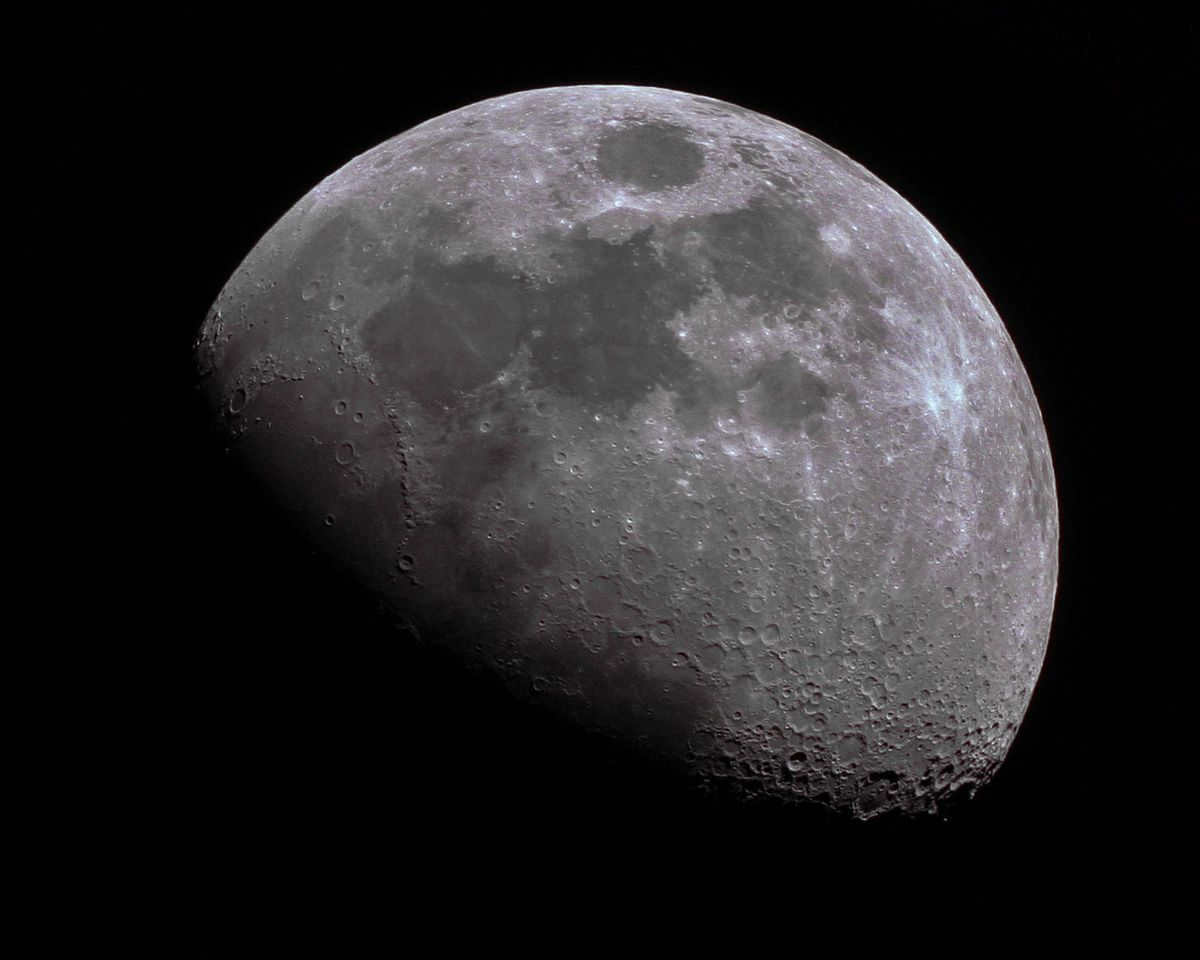
Throughout the years, extensive observations and studies have been conducted on the moon as it is our closest celestial companion. It came into existence approximately 4.51 billion years ago, a mere 60 million years after the birth of the solar system itself. Remarkably, it is the sole natural satellite that revolves around planet Earth.
Over the course of the past five decades, an immense volume of research has been devoted to understanding the moon’s origin, geology, composition, and its impact on our planet. Taking into consideration these comprehensive investigations, we have compiled a compilation of the most intriguing facts about the Moon.
Moon characteristics
Equatorial radius: 1738.1 kilometers
Surface gravity: 1.62 m/s 2
Escape velocity: 2.38 km/s
Average surface temperature: -53.15°C (at the equator)
Fascinating Moon facts
1. The Moon is known by various names, including “Luna” (Latin) and “Selene” (Greek).
2. The term “lunatic” or “lunaticism,” which usually refers to mental illness, is derived from the Latin word for the moon. Since ancient times, there has been a widespread belief that the full moon causes insanity, traffic accidents, and suicides among vulnerable individuals. However, these beliefs have been repeatedly debunked.
3. The Moon’s orbit around the Earth is synchronized with its rotation on its axis (shown on the left), resulting in tidal locking on one side of the Moon that always faces the planet. On the right, there is a depiction of a scenario where the Moon does not rotate on its axis.
4. When a total solar eclipse occurs, the Moon covers a significant portion of the Sun. This is because the Sun is approximately 400 times farther away from Earth than the Moon and appears to be the same size.
5. It is estimated that there are approximately 300,000 impact craters on the near side of the Moon.
6. The collective weight of man-made or human-made objects on the Moon is over 191,000 kilograms. This includes crashed probes and malfunctioning rovers.
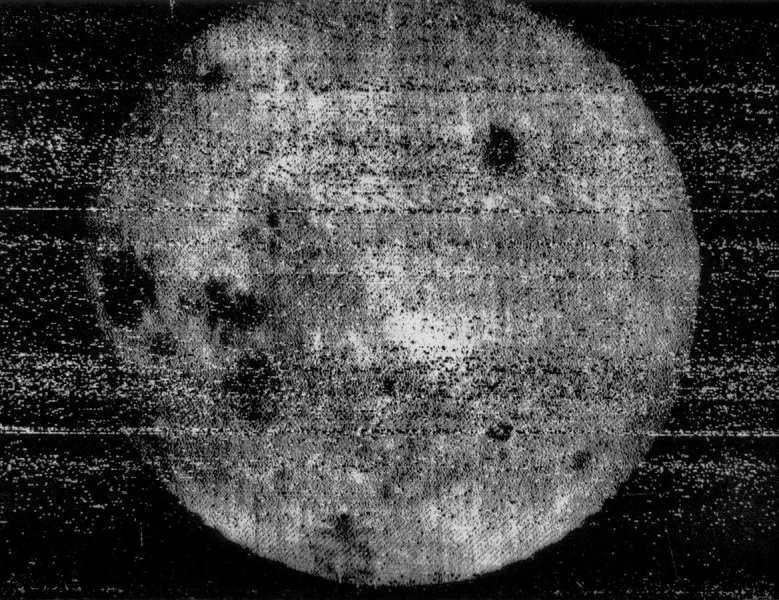
7. On October 7, 1959, the Soviet Luna-3 spacecraft captured the first-ever image of the far side of the Moon, which is always facing away from Earth.
8. In September 1959, the Soviet Luna 2 lunar lander became the first human-made object to successfully land on the surface of the Moon.
9. Approximately 59% of the Moon’s surface is observable.
Due to the phenomenon of lunar libration, which causes the Moon to have a fluctuating motion, Earth observers are able to see around 59 percent of the Moon’s surface, even though one hemisphere always faces the Earth. This is higher than the expected 50 percent visibility, making it possible to observe a larger portion of the Moon’s surface.
10. In our solar system, it is the fifth largest natural satellite.
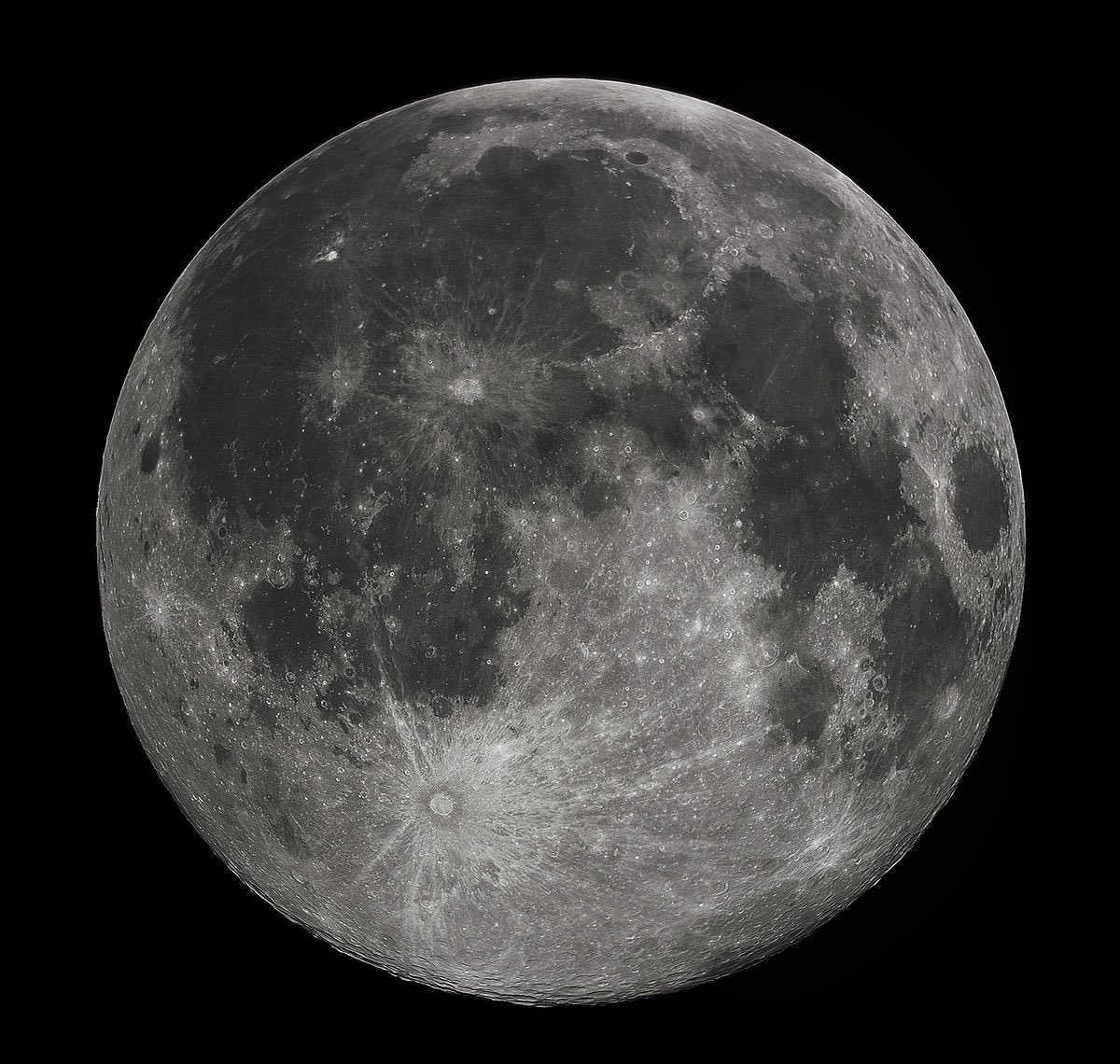
In our solar system, there are approximately 205 natural satellites, with irregular moons being the most common. All planets except for Mercury and Venus have natural satellites. Among these, the largest and most massive is Ganymede, which belongs to Jupiter. Interestingly, Ganymede is the only natural satellite known to have its own magnetic field.
Following Ganymede, Saturn’s moon Titan is the next largest, with Jupiter’s moons Callisto and Io coming after. Our own moon, with a diameter of 3476 kilometers, ranks fifth in terms of size.
11. The solar system is home to the second largest impact crater.
One of the most distinctive geological features of the moon is a massive lunar crater, measuring 2500 km in diameter and approximately 8 km in depth, located on its far side. This impact crater, known as the South Pole-Aitken Basin, is not only the oldest and deepest crater ever found, but it also holds the title for being the second largest confirmed crater in the entire solar system, with the Plain of Utopia impact crater on Mars taking first place.
The South Pole-Aitken Basin was first discovered in the mid-1960s, but it wasn’t until the 1990s that scientists started to gain a better understanding of this crater. More recently, researchers have made an intriguing discovery: a massive foreign object, potentially of extraterrestrial origin, buried deep within the basin.
12- The moon’s size is decreasing, leading to lunar earthquakes
Based on data collected by the Lunar Reconnaissance Orbiter, it has been observed that the Moon has reduced in size by approximately 50 meters over the span of several million years. This decrease in size is a result of the gradual cooling of the Moon’s interior, which has caused the formation of new “tremor faults” on its surface. An apt comparison for this phenomenon would be the transformation of grapes into raisins. Just as grapes develop wrinkles when they shrink, these fault lines on the Moon are a result of its contraction and they are responsible for lunar earthquakes.
A similar shrinkage phenomenon is also occurring on the planet Mercury. According to research, this fiery planet has contracted by at least 11 kilometers since its formation 4.5 billion years ago.
13. The areas of the Moon’s surface that appear darker in color are known as “Maria”
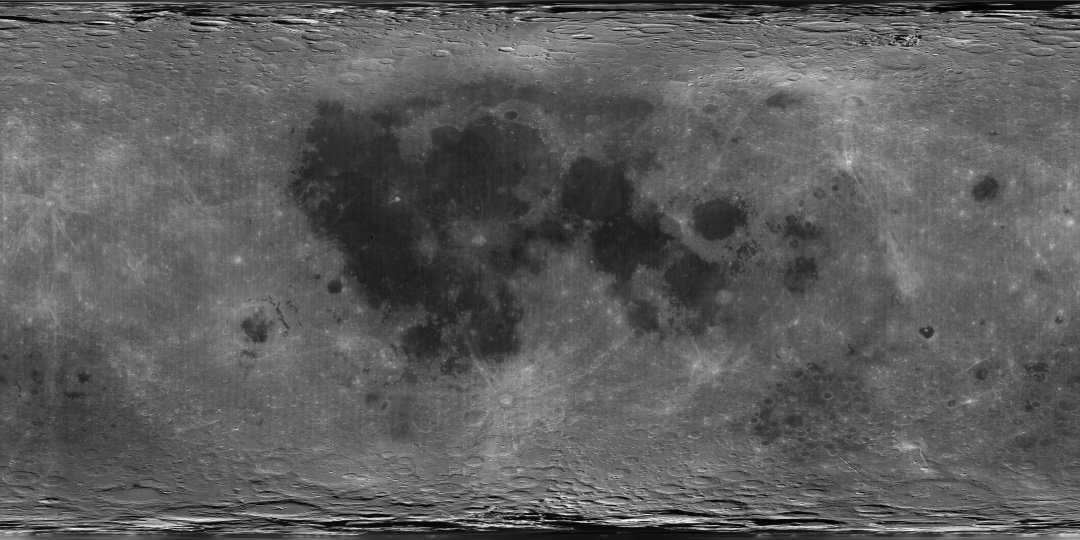
The dark areas visible on the surface of the Moon are actually expansive basins of basaltic lava. These basins, known as “maria” in Latin, meaning “seas,” appear dark to the naked eye due to their higher iron content and lower reflectivity compared to terrestrial basalt.
Most of the maria are situated on the side of the Moon that faces Earth, covering approximately 16% of the total lunar surface. Radiometric dating suggests that the youngest lunar maria are around 1.2 billion years old, with the majority of them forming between 3 and 3.5 billion years ago.
The largest known maria, called the Ocean of Storms (Oceanus Procellarum), is located on the western side of the near side of the Moon and spans an area of approximately 4,000,000 km2.
14. The Moon used to possess a magnetic field strength comparable to that of the Earth.
Compared to the Earth’s magnetic field, the Moon currently has a very weak magnetic field, believed to be less than 0.2 nanotesla. This is because it lacks an active dynamo, which is responsible for generating magnetic fields on Earth and other planets. Any magnetic field strength observed on the Moon is the result of a phenomenon called the magnetization of the Earth’s crust (crustal magnetic field).
However, this hasn’t always been the case. Research indicates that the Moon had a powerful magnetic field similar to Earth’s at the beginning of its existence around 4 billion years ago.
Evidently, the Moon lost most of its magnetic field strength approximately one billion years ago when its core cooled and solidified.
15. In the past, the atmosphere of the Moon was denser.
During previous times, the Moon had a denser atmosphere. A study conducted by researchers from the Lunar and Planetary Institute and Marshall Space Flight Center in 2017 revealed that approximately 3 to 4 billion years ago, the Moon’s atmosphere was twice as thick as the atmosphere of present-day Mars.
The thicker atmosphere of the Moon during ancient times is believed to have been a result of frequent gas emissions during volcanic eruptions, which lasted for approximately 70 million years before dissipating into space. This conclusion is based on the analysis of lunar magma data collected by the Apollo missions.
16. The Moon’s North Pole: The New Coldest Place in the Solar System
Pluto, once considered the coldest place in the solar system with a surface temperature of -240 degrees Celsius, has been dethroned. Thanks to data collected by the LRO DIVINER instrument, which analyzes temperature variations on the lunar surface, scientists have discovered an even colder spot.
In 2009, researchers studying the data found that one of the craters near the Moon’s North Pole, known as Hermit, experiences nighttime temperatures as low as -274 degrees Celsius. This makes it the new record holder for the coldest place in the solar system.
Interestingly, the study also revealed that there are several other craters in the same region with almost identical temperatures. It seems that the Moon’s North Pole is truly a frigid and inhospitable place.
17. The Moon is Getting Farther from Earth
After its formation, the Moon was believed to be about 22,500 kilometers away from Earth. Over the course of 4.5 billion years, this distance has now increased to an average of 384,400 km. It is evident that the Moon is gradually moving away from our planet. The rate at which this is occurring is approximately 4 cm per year.
Although the current rate at which the Moon is moving away from the Earth may seem insignificant, it can have significant consequences for the Earth-Moon system over a long period of time.
18. No manned missions to the Moon have taken place since 1972.

From 1969 to 1972, the Apollo program, conducted by NASA, achieved six successful manned landings on the moon, a remarkable achievement that has yet to be replicated by any other country.
The final mission of the Apollo program, Apollo 17, set several records. Astronauts Eugene Cernan and Harrison Schmitt spent over three days on the moon, making the longest lunar trek and spending the most time in lunar orbit up to that point in history. Additionally, the lunar samples collected during the mission are the largest in terms of total mass compared to any other Apollo mission.
Following the Apollo 17 mission, there were no crewed missions to the moon for over four decades. However, plans are now underway to change that, indicating a potential return to the lunar surface in the near future.
In May 2019, NASA announced that its Artemis program will carry out the next manned lunar exploration by 2024.
19. The U.S. Air Force contemplated detonating a nuclear bomb on the Moon.
In 1958, known as Project A119, the U.S. Air Force devised a plan to explode a nuclear bomb on the surface of the moon.
After the initial successes of the Soviet Union in the space race in the late 1950s, the U.S. Armed Forces largely believed that a display of force of this magnitude was necessary to uplift the morale of the American population. Another motivation for such an ambitious project was the widespread rumor that the Soviets were intending to detonate a hydrogen bomb on the Moon.
Regardless, Project A119 was terminated without making significant progress, primarily due to concerns about negative public reaction and the potential for a major nuclear mishap on Earth.
The confidential project was initially announced in 2000 by a former NASA executive who spearheaded the endeavor back in 1958.
Timeline of lunar exploration
1959: On September 13, 1959, Luna 2 achieved the distinction of being the inaugural man-made object to successfully touch down on the lunar surface. Just under a month later, on October 6, Luna 3 captured the initial photographs of the far side of the Moon from a spacecraft. Both missions were part of the Soviet Luna program.
1966: Luna-9 accomplished the groundbreaking feat of making a smooth landing on the Moon’s surface on February 3, 1966, effectively becoming the first spacecraft to do so. This marked the first time such a landing had been achieved on an extraterrestrial body. Subsequently, in early March, Luna-10 made history by becoming the first space probe to successfully enter and maintain orbit around the Moon.
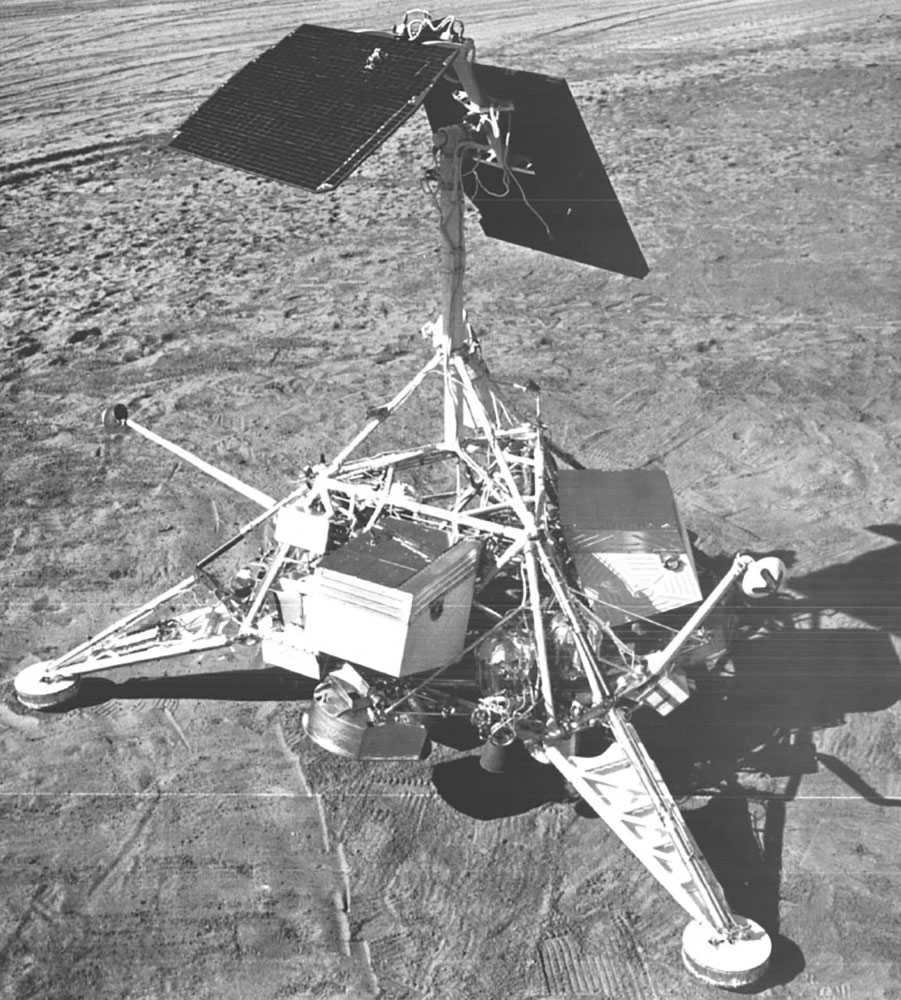
NASA and the United States did not achieve any significant milestones in early lunar exploration until June 1966, when Surveyor 1 accomplished a successful soft landing on the lunar surface. Then, in August, Lunar Orbiter 1 became the second artificial satellite and the first American one to orbit the Moon.
1969: On July 20, 1969, the Apollo Lunar Module Eagle, carrying Neil Armstrong and Buzz Aldrin, two American astronauts, successfully touched down on the Moon. This was the first and only manned space mission to land on a celestial body.
The landing was a part of the iconic Apollo 11 mission, which effectively concluded the space race between the Soviet Union and the United States.
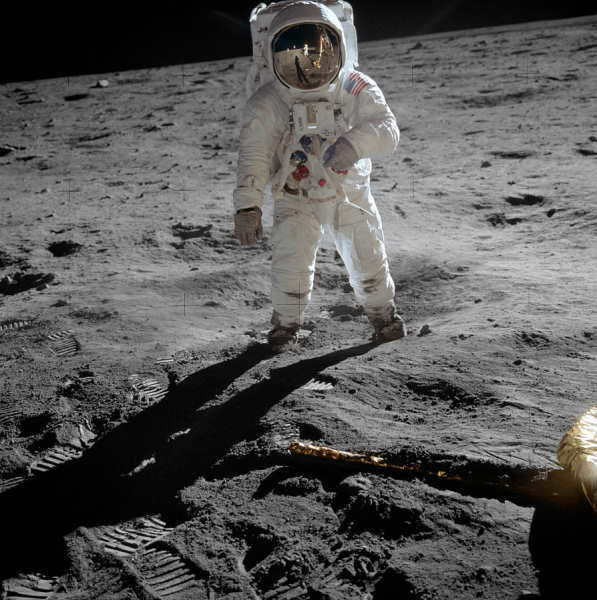
Following the Apollo 11 mission, Apollo 12 quickly followed as the second successful crew to land on the moon out of the six that have done so thus far. One of the primary goals of the mission was to bring back various components of the robotic probe Surveyor 3, which had previously landed on the moon two years prior. This marked the first and only time that humans returned to a probe on another celestial body.
1970: The Soviet space program achieved significant accomplishments with their Luna-16 and Luna-17 missions. In September 1970, the Luna-16 robotic space probe successfully completed the first fully automated collection of samples from the moon’s surface. A small portion of this sample was sold in 2018 for $855,000.
On November 10, 1970, Lunokhod-1 accomplished a groundbreaking feat by becoming the inaugural autonomous lunar rover to explore the surface of the Moon. This remarkable achievement marked the first instance of a wheeled vehicle traversing a celestial body other than Earth. The Luna-17 spacecraft played a crucial role in delivering the lunar rover to its destination.
Throughout history, humanity has gazed upon the Moon with a sense of awe and wonder, marveling at its radiant brilliance. This celestial neighbor has been faithfully circling the Earth since the dawn of time, capturing the attention of the earliest human observers. Driven by an insatiable curiosity and propelled by the forces of evolution, we embarked on a journey of discovery, meticulously documenting the Moon’s inherent behaviors and discerning intricate patterns within its movements.
Take, for instance, the Moon’s axis of rotation aligning with its orbital rotation. In reality, the satellite exists within a gravitational lock, resulting in us constantly facing the same side (hence the concept of the enigmatic far side of the Moon). Due to its elliptical trajectory, this celestial object intermittently appears larger or smaller.

Characteristics of the Moon’s Orbit
The Moon’s orbit is not a perfect circle around the Earth, with an average eccentricity of -0.0549. This means that the distance between the Moon and the Earth varies throughout its orbit. On average, the Moon is about 384,748 km away from the Earth. However, this distance can range from 364,397 km to 406,748 km.
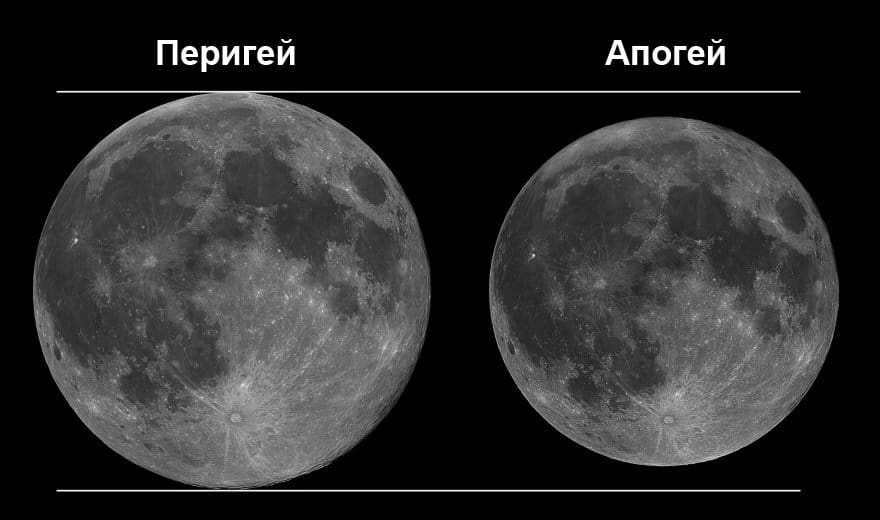
Comparison of the apparent size of the Moon at its closest point (perigee) and farthest point (apogee)
This leads to variations in the Moon’s angular velocity and observed size. During the Moon’s full phase and when it is at its closest position to the Sun (perihelion), we perceive it to be 10% larger and 30% brighter than when it is at its farthest point (maximum distance) from the Earth.
The average inclination of the Moon’s orbit with respect to the plane of the Earth’s orbit around the Sun is 5.155°. The Moon’s sideric period (time taken to complete one orbit around the Earth) and axial period (time taken for one rotation on its axis) coincide, resulting in a synchronous rotation. This is why there is a “dark side” of the Moon that is perpetually hidden from view.
In addition to orbiting the Earth, the Moon also revolves around the Sun, completing one synodic period (time taken for the Moon to return to the same phase) in 29.53 days.
Lunar Cycle Orbit
The lunar orbit creates the various phases of the Moon – the perceived transformation in the visual aspect of a celestial entity in the sky caused by fluctuations in the level of illumination. When the star, planet, and satellite align, the angle between the Moon and the Sun is 0 degrees.
A proficient tarot reader will address the following inquiries:
What lies ahead in your future? How will the dynamics of your relationships unfold? What course of action should you take?

During this time, the side of the moon that is closer to the Sun receives the most sunlight, while the side facing us remains in darkness. As time progresses, the angle between the Sun, moon, and Earth increases. After the New Moon phase, the Sun, moon, and Earth are separated by 90 degrees, resulting in a different appearance of the moon. The diagram below provides a detailed explanation of how the different lunar phases are formed.
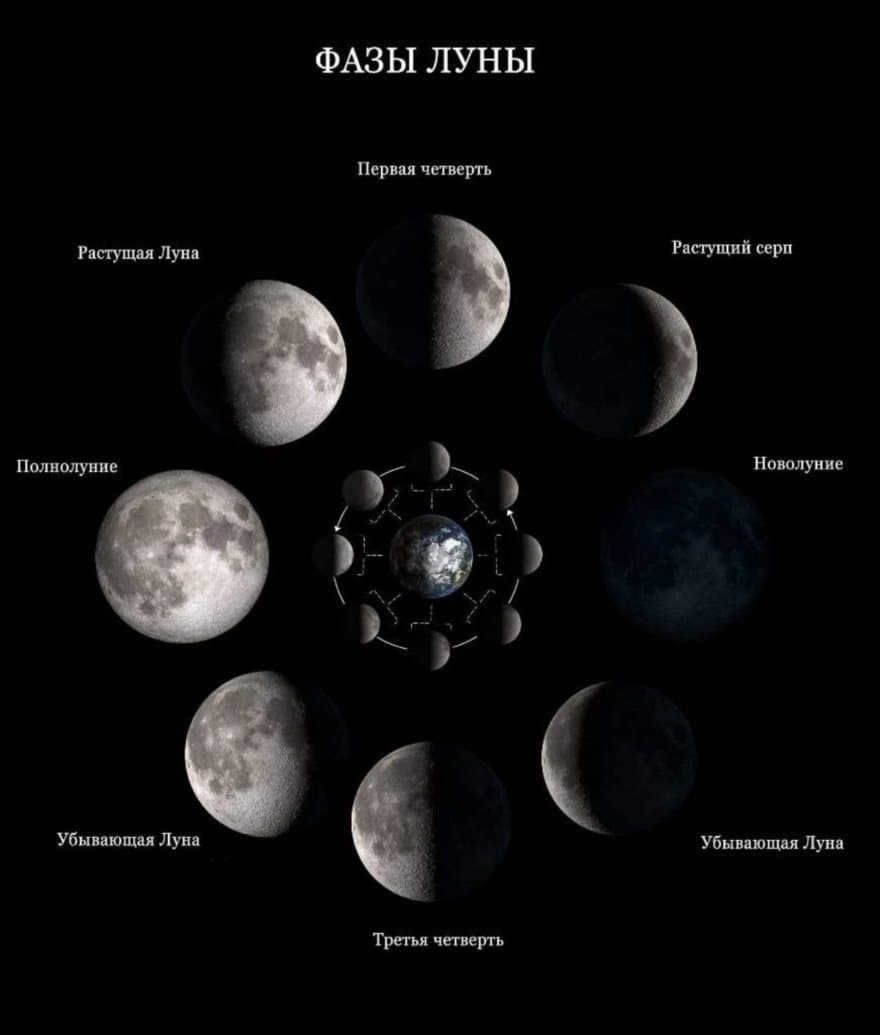
If they are positioned in opposite directions, the angle measures 180 degrees. The lunar cycle has a duration of 28 days, during which the satellite undergoes phases of waxing and waning.
During the first quarter, the Moon appears less than half full and is in the waxing phase. Following this is the transition beyond the halfway point, where the Moon starts to wane. Finally, we reach the last quarter, where the other side of the lunar disk is already illuminated.
The future of the Moon’s orbit
It is already known that the Moon is gradually moving away from the Earth, at a rate of 1-2 cm per year. This has the interesting effect of making our day slightly longer, by about 1/500th of a second, every century. So, around 620 million years ago, the Earth had only 21 hours in a day.
Currently, our day covers 24 hours, but the Moon continues its attempt to escape. We have become accustomed to having the Moon as our satellite, and it would be a loss to no longer have it as a partner. However, the dynamic between these celestial bodies is changing, and I am curious to see how it will impact us.
- Fascinating facts about the Moon
- What is the Moon?
- The process of Moon formation
- How the Moon was formed
- Constructing a lunar base: Part 1
- Constructing a lunar base: Part 2
- Constructing a lunar base: Part 3
- Constructing a lunar base: Part 4
- How can we destroy the moon?
- How can we prove that the lunar landing was not fake?
- Is the moon necessary for our survival?
- How can we make money from the moon?
- How did NASA document the departure of astronauts from the moon?
- Which is a better destination: Mars or the moon?
- Isn’t it about time we return to the moon?
- What is the actual name of the moon?
The position and movement of the moon
- The moon’s orbit
- The relationship between the sun and the moon
- Why doesn’t the sun consume the moon?
- What are the different phases of the moon?
- What is a crescent moon?
- Why does the moon appear so large?
- Why is the moon moving away from Earth?
- Why can we see both the sun and the moon at the same time?
- How long does it take to travel to the moon?
- Distance between Earth and Moon ;
- Rotation of the Moon ;
- The Moon’s back side ;
- Earth’s second satellite is departing from us
- The moon’s surface ;
- Presence of water on the Moon
- New craters discovered on the Moon
- The process of crater formation on the Moon
- Existence of lava tubes on the Moon
- The first individuals to set foot on the Moon
- How many people have been to the Moon?
- What lies on the far side of the Moon?
- Old NASA equipment visible on the Moon
- Possibilities of terraforming the Moon
- Presence of toxic substances on the Moon
- The Moon’s atmosphere ;
- Gravity on the Moon ;
- Age of the Moon ;
- Temperature on the Moon ;
- Reasons behind the Moon’s illumination
- Explanation for the appearance of a “man on the moon”
- What is the reason for the absence of seas on the opposite side of the Moon?
- The Moon’s hue;
- The Tranquil Sea;
Astrophysicists have revealed that the Moon is indeed moving closer to Earth. Scientists have long suspected that the natural satellite of our “blue planet” behaves oddly. They have now determined the Moon’s trajectory and how it affects our planet.
What is the direction of the Moon’s movement relative to the Earth?
The Moon has long been the subject of fascination and intrigue, with numerous mystical stories and legends surrounding it. Throughout history, people from different cultures have been captivated by the allure of the lunar orb.
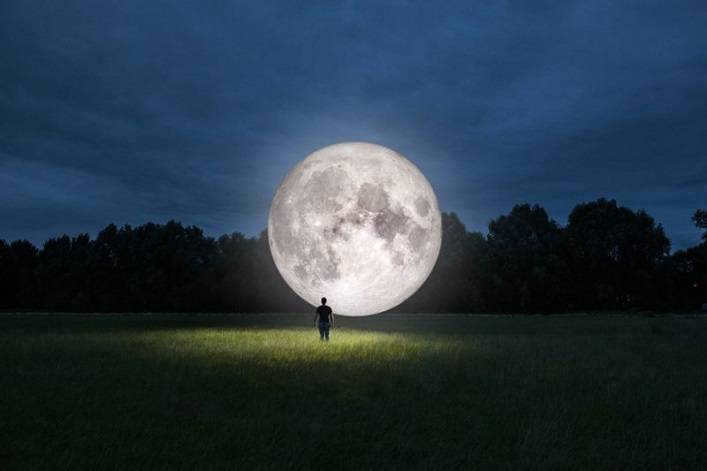
In different eras, scientists have gradually revealed the mysteries surrounding the Moon. The advancement of science and technology has allowed astrophysicists to discover that Earth’s natural satellite not only orbits around our planet, but also gradually distances itself from it.
The reasons behind the Moon’s “retreat” from Earth are still unknown to scientists. One widely accepted theory suggests that various cosmic forces exert an influence on our planet, which in turn affects the Moon’s movement.
What is the speed at which the Moon is distancing itself from the Earth?
Billions of years ago, the Earth’s natural satellite was in much closer proximity. During a specific era, the Moon was only 340,000 kilometers away from the Earth. Additionally, the duration of a day during this period was limited to 18 hours.
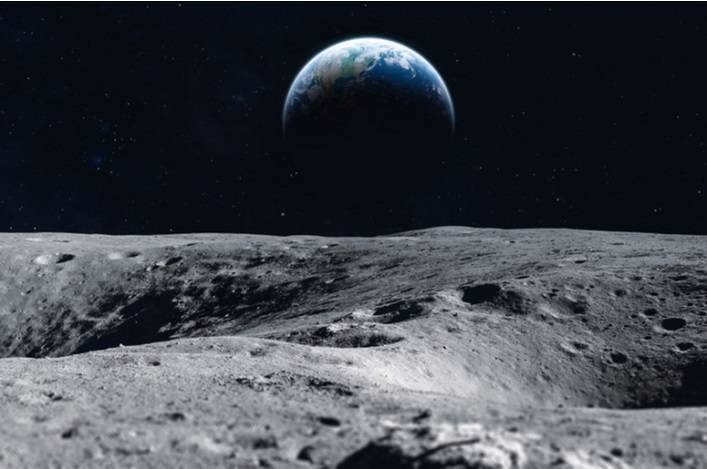
As stated on the 1rre website, the Moon has gradually increased its distance from Earth by approximately 40,000 kilometers, leading to the lengthening of the day to 24 hours.
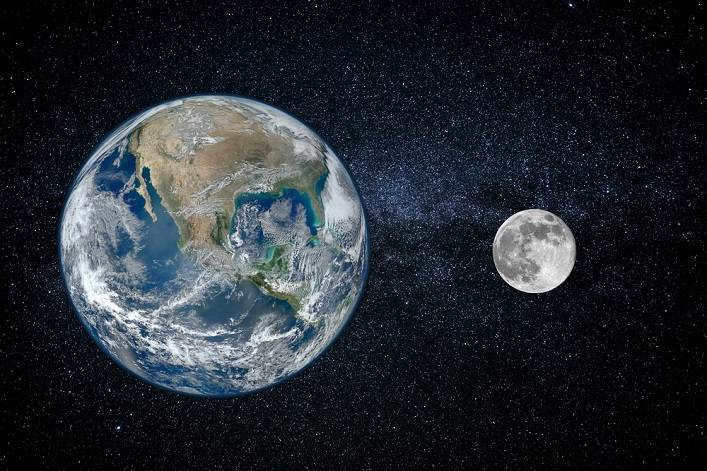
At a certain point, the distance between the Earth and the Moon will have an impact on the duration of a day. It may stretch up to 47 hours, but humanity won’t have to face this phenomenon until billions of years from now.
The movement of the Moon away from the Earth not only affects the length of day and night, but also has an influence on the rotational speed of the inhabited planet. As a result, there are fluctuations in the strength of tides, earthquakes, and other natural abnormalities.
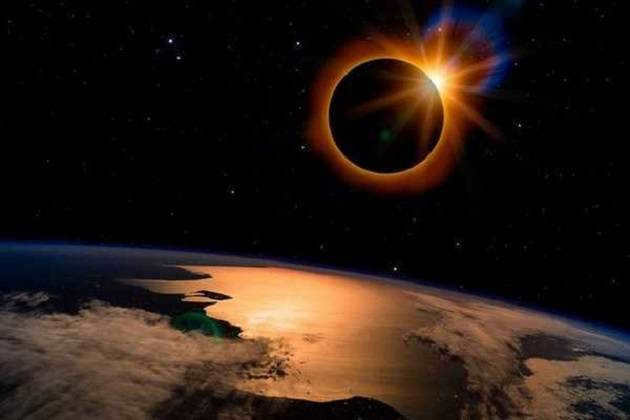
Climatologists have observed a recurring pattern in the occurrence of earthquakes, volcanic eruptions, and tsunamis. There are certain years when these natural disasters are infrequent and their impact is minimal. However, there are also periods of time when these events result in widespread devastation and loss of life.
Scientists have established a connection between the cyclical and periodic changes in Earth’s climate and the movement of the Moon and its distance from our “green planet”.
When the Earth gets closer to the Moon
Each year, there is a celestial event known as the “super moon” that captures the attention of news portals. During this time, the lunar sphere appears visually bigger in the night sky.
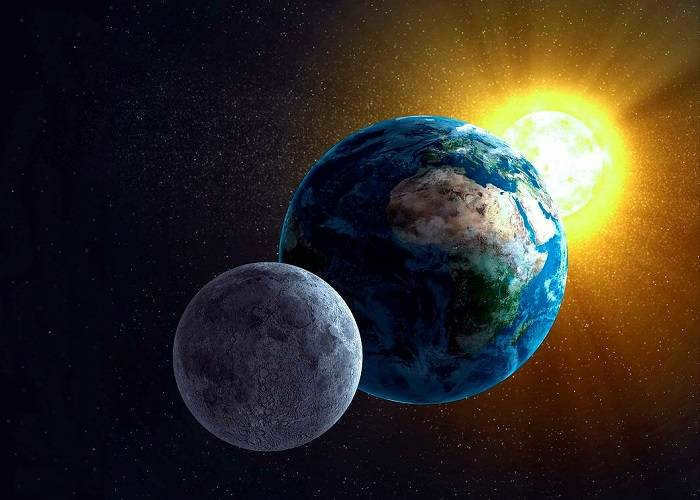
One of the reasons why the Moon moves away from the Earth is because as they both travel along their respective orbits, they eventually reach a certain point of convergence known as perigee. During perigee, the distance between the Earth and the Moon is less than 362 thousand kilometers.
The most visually stunning supermoon occurs when there is a 2-4 day gap between perigee and the full phase of the Moon.
Despite the advancements in astrophysics, the Moon still holds many mysteries that have yet to be fully explained.
Gravitational force serves as the most powerful connection between the Earth and the Moon. The Moon’s gravitational pull results in a deceleration of the Earth’s rotation, while the Earth’s gravity leads to an expansion of the Moon’s orbit. As a result of tidal interaction between the Earth and the Moon, the Moon gradually distances itself from the Earth at a rate of 3.78 centimeters per year.
What causes the Moon to move away from the Earth?
The Moon’s gravity generates a tidal wave in the Earth’s oceans. This tidal wave imparts a certain degree of force to the Moon’s orbital movement, enabling it to gradually push away from the Earth.
The Moon’s retreat from the Earth occurs at such a slow pace that it would require billions of years to witness the Earth without the presence of the Moon.
What would happen to the Earth in the absence of the Moon, and could we survive without it?
The presence of the moon has a significant impact on the Earth, playing a crucial role in maintaining stability.
It is widely known that the moonlight enables us to perceive objects, even if only as shadows. However, if the moonlight were to disappear, these figures would be entirely invisible, much like closing our eyes.
The moon’s gravitational pull slows down the Earth’s rotation. Without this influence, the rotation rate of the Earth would accelerate.
Consequently, without the moon’s presence, days would be significantly shorter, lasting only between six to twelve hours. Additionally, there would be over a thousand days in a year.
One of the moon’s key effects is the creation of tides on our planet. Without the moon, the tides would be substantially lower in magnitude.
It is common knowledge among those with even a passing interest in space that the Moon is gradually moving away from the Earth. Frequently, people inquire about this phenomenon:
This article will address these inquiries.
Based on our current scientific knowledge, the Moon was formed through a collision approximately 4.5 billion years ago when a protoplanet, similar in size to Mars, crashed into the Earth. As a result of this collision, the material that eventually formed the Moon was expelled into space.
Due to the Moon’s gravitational pull, specific areas of the Earth are pulled towards it more forcefully, resulting in tidal bulges in our planet’s oceans. As the Earth rotates at a much faster speed than the Moon, these bulges occur slightly earlier than the Moon’s position, causing the Moon to be pushed into a higher orbit around the Earth due to various physical phenomena.
It is perilously simple to underestimate the Moon. The same holds true for the Sun. However, if it were not for their eternal existence in our skies, life on Earth would be drastically different from its current state and would not be particularly enjoyable for us!
However, our sole natural satellite, the Moon, is actually increasing its distance from Earth. Its orbit is expanding year after year!
The influence of tidal forces
For over 4.5 billion years, the Moon has been in orbit around the Earth. Because the Earth has a larger mass, it exerts a significantly stronger gravitational force on the Moon compared to the Moon’s gravitational force on the Earth. As a result, the Moon is pulled towards the Earth with greater force, leading to the creation of tidal forces that produce tides in our oceans.
The gravitational attraction between the Moon and the Earth is most powerful on the side of the Earth that directly faces the Moon. This force is particularly strong in the region that is closest to the Moon, where the distance between the two celestial bodies is at a minimum.
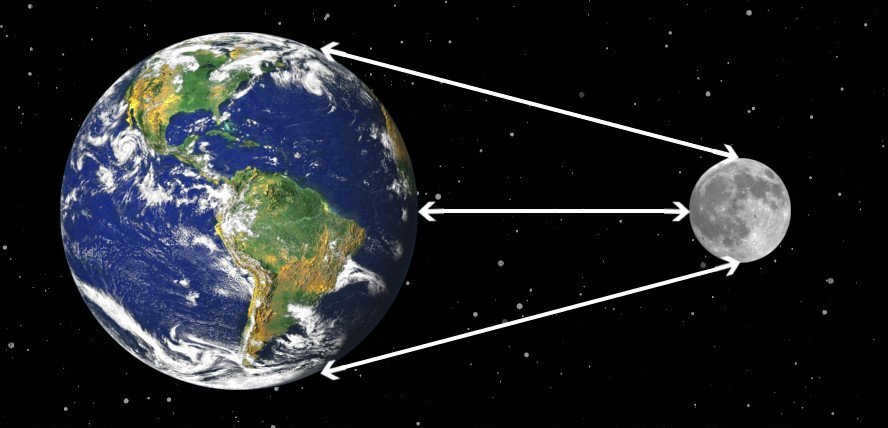
As depicted in the image above, the Earth’s Equatorial region, which lies in the middle, is in closer proximity to the Moon compared to the polar regions at the top and bottom. Consequently, the Moon exerts a slightly stronger gravitational force on the equatorial regions. This increased gravitational pull results in the formation of high tides in the ocean waters within this area, leading to the creation of a bulge in the middle section of the Earth. This phenomenon is commonly referred to as a tidal bulge or equatorial bulge.
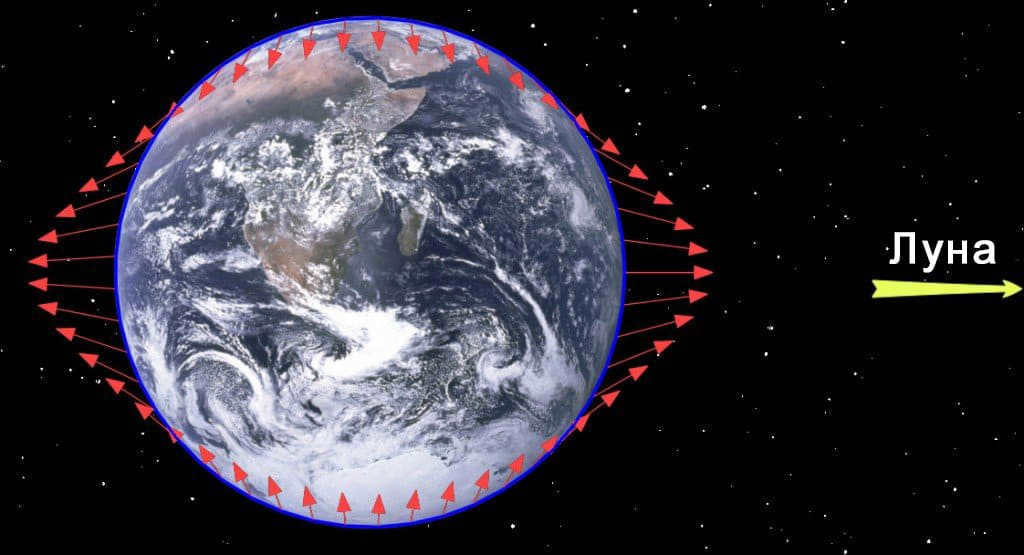
This is the way ocean tides behave depending on the Earth’s position in relation to the Moon. It is evident from this that the ocean goes through tides when it is nearest to the Moon.
Both sides experience the impact of tidal forces, meaning that just as our planet encounters a bulge (it is important to note that this bulge only distorts the Earth’s physical structure by a few centimeters) caused by the Moon’s gravitational force, the Moon itself also experiences a tidal bulge on its side closest to the Earth.
The Revolution of the Moon and Earth
The Moon’s drifting movement can be attributed to the revolution of both the Earth and the Moon. The Earth spins at a rapid rate, completing one rotation on its axis in just 24 hours. On the other hand, it takes the Moon 27.3 days to complete one rotation on its axis. Clearly, the Moon’s rotation is much slower compared to that of the Earth.
Due to the significant difference in their speeds, the tidal bulge on Earth exerts a force on the Moon, trying to pull it forward in its orbit and causing a slight acceleration. As per Newton’s third law, for every action, there is an equal and opposite reaction. Therefore, the Moon is also pushed away by the Earth’s tidal bulge, resulting in a decrease in the Earth’s rotational velocity.
As the Earth’s rotational velocity decreases, it experiences a reduction in angular momentum (rotational energy). This energy loss is then transferred to the Moon’s orbit through tidal force, causing the Moon’s orbit to gradually expand over time.
Consequently, the Moon’s circular path around the Earth is expanding at a rate of 3.8 centimeters per year. In simpler terms, the Moon is moving away from the Earth by 3.8 centimeters annually.
Similarly, the Earth’s rotation speed is decreasing to the extent that in 100 years, one day on Earth will be 2 milliseconds longer than its current duration.
To summarize, it is true that the Moon is moving away from us, although this process is occurring at a very gradual pace. Therefore, there is no need to be concerned about lengthy periods of moonless nights in the near future!
Our planet possesses a solitary satellite, which happens to be the Moon. Gradually, this celestial entity is gradually moving away from Earth. The gap between the Moon and Earth is expanding at a rate of roughly 3.8 centimeters annually. Immediately after its formation, the Moon had a much closer proximity to our planet. Experts estimate this distance to be around 60,000 kilometers. To provide some context, it’s worth noting that geostationary satellites orbit at an elevation of 35,786 kilometers.
In ancient times, the duration of a day on Earth was only about 5 hours. However, as time passed, the Earth’s rotation began to decelerate, resulting in an increase in the distance to the Moon. What is the reason behind this phenomenon?
The Carboniferous Period
Approximately 350 million years ago, during the Paleozoic Era, prior to the emergence of dinosaurs, a single day on Earth was less than 23 hours in duration. This fascinating discovery was made through the examination of fossilized coral remains. Additionally, the length of a year during this time period was measured to be 385 days. Intriguingly, the Moon’s proximity to Earth was 13,300 kilometers closer than its current position, resulting in a slightly larger angular size when observed in the sky.
In the coming future, the length of days on our planet will progressively increase. This elongation will continue until the Moon and Earth achieve a synchronized orbit, where one revolution of Earth around its axis will align with one revolution of the Moon around Earth. However, it should be noted that this synchronization will have no direct impact on our planet, as it is projected to occur long after the Sun has transformed into a red giant. The ultimate survival of Earth in such a scenario remains uncertain, posing a significant question for the future.
What causes the Moon to move away?
The phenomenon of the Moon moving away from the Earth is primarily due to the tidal interaction between the two celestial bodies. Currently, the Moon is tidally locked to the Earth, meaning it takes the same amount of time to complete one rotation on its axis as it does to orbit our planet. As a result, we only see one side of the Moon’s surface at all times. However, the Earth’s orbit around the Moon has not yet synchronized with this tidal locking.
The gravitational force of the Moon causes deformations on the Earth’s surface along the Moon-Earth axis. This effect is not only seen in ocean tides, but also in the solid parts of our planet. Although not as noticeable, the tidal bulge on the Earth’s surface is constantly moving towards the Moon. This continuous tidal motion has an interesting consequence – in order for the system to remain stable, the Earth must slow down its rotation.
However, due to the fact that the Earth-Moon system’s angular momentum remains constant and the Earth’s rotation slows down, it necessitates the Moon to speed up. As a consequence, our satellite will gradually move away from us and into the vast expanse of space, bidding us farewell with a tearful wave of a handkerchief. This separation occurs at a rapid pace, specifically at a rate of 3.8 centimeters per year, as mentioned earlier in this article.
Ultimately, this process will lead to the Earth attaining a rotational speed that matches the Moon’s orbital period.
Diverse phenomena of a similar nature are not limited to this situation
The Pluto-Haron system serves as another prominent illustration of such a phenomenon. In this case, both celestial bodies are already in a state of synchronized orbit, resulting in Charon being visible exclusively from one side of Pluto.
Moreover, when there is a significant disparity in mass between the orbiting bodies, an intriguing occurrence called orbital resonance arises. A notable example of this can be observed in the rotation of Mercury. Due to the Sun’s considerably larger size, Mercury experiences a 3:2 orbital resonance, meaning that it completes three rotations around its axis for every two revolutions around the Sun.
When it comes to Saturn, there is a phenomenon where some of its moons are in a state of orbital resonance with one another. One example of this is the relationship between Titan and Hyperion, where Titan completes 3 orbits around Saturn for every 4 orbits that Hyperion completes. Similarly, Jupiter also experiences this phenomenon with its moons Ganymede and Europa. Ganymede and Europa are in a 1:2:4 orbital resonance with Jupiter, meaning that for every 2 and 4 orbits that Jupiter completes, Europa and Ganymede complete 1 orbit respectively.
Is it possible for the Moon to break free from the Earth?
No, it is not. Despite any desire it may have, the Moon will eventually reach a point where the gravitational pull of the Earth will no longer have an impact on its rotation. At that stage, our satellite will essentially be stationary over a single point on the Earth’s surface, observable only from one side of the planet. According to certain astronomers, this event is not expected to occur for another 50 billion years. It is highly unlikely that any of us will be alive to witness it….
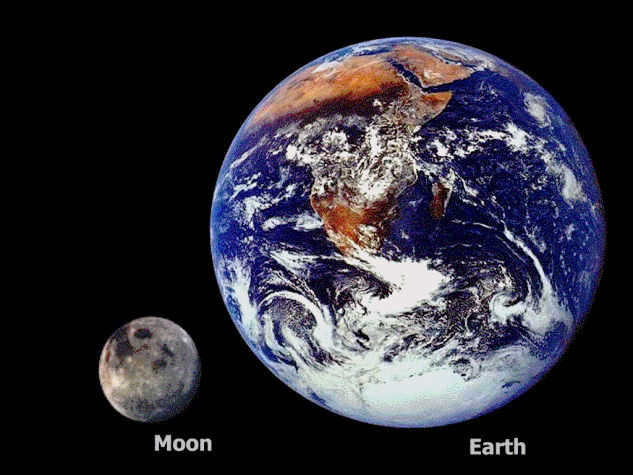
While the Moon has always been acknowledged as a natural celestial object, there has recently been speculation surrounding its artificial origins. This speculation arises from the presence of certain man-made looking objects on the Moon, which have intrigued scientists.
The Moon is known for its perpetually black sky, lack of atmosphere, and absence of sound. Yet, it also boasts seas, oceans (formed by frozen lava), and craters. Scientists continue to ponder the Moon’s formation and its current position.
The Moon consistently moves away from the Earth by 3.8 cm. Some scientists even suggest that in 50 billion years, the Moon will completely escape from Earth’s gravitational pull. However, this theory is met with skepticism from many other researchers.
Furthermore, it is postulated that within the satellite resides a metallic nucleus, enveloped by a triad of mantle layers and a heterogeneous crust which may measure up to 100 km in thickness.
What is the ratio of the Earth’s size to that of the Moon?
Researchers have long since determined that the celestial body is 6 times tinier than its azure counterpart. To ascertain the number of times that the Earth surpasses the Moon in magnitude, one need only observe the image. This is due to the fact that visual data is more easily comprehended. The following image reveals the disparity in size between the Earth and the Moon. The contrast is truly staggering!
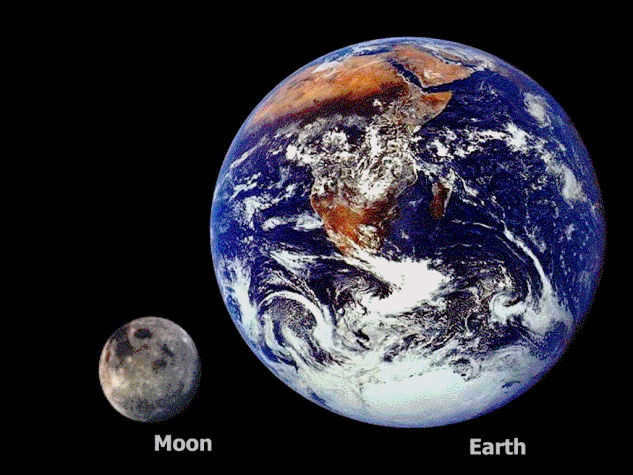
When viewed from Earth, the Moon appears quite small, measuring about 30 cm in diameter. However, when observed from the horizon, its size becomes more impressive.
The Moon has a radius of 1737.1 kilometers, while the average radius of the Earth is 6371.0 km. Therefore, the Moon is approximately 3.667 times smaller than the Earth.
How many times larger is the Earth’s diameter compared to the Moon’s diameter (which is equal to two radii)? This measurement is 3,476 kilometers. It is with these numbers that the distance from Moscow to Tomsk is calculated. As you may know, the equatorial diameter of the Earth is 12,757 km. This means that the Moon’s diameter is four times smaller than that of the Earth. Specifically, the Moon’s diameter is equal to 0.272 of the Earth’s diameter.
What is the ratio between the size of the Earth and the Moon in terms of area? The Moon has a surface area of 37.93 million square kilometers, while the Earth has a surface area of 510.1 million square kilometers. This means that the Earth is approximately equal in size to the combined areas of three countries – Russia, Canada, and China.
How many times is the Earth larger than the Moon in terms of volume? The Moon is almost 50 times smaller than the Earth, occupying only 2% of its volume.
The satellite has a density of 3.34 g/cm³, which is only 60% of the Earth’s density. This difference in density is due to the Earth’s larger size and the increased pressure on its interior. The Earth’s interior consists of a massive core that makes up 32% of its total mass, whereas the Moon’s core makes up no more than 5% of its mass and is about 350 kilometers in size.
The Earth is 81 times larger in mass than the Moon. Newton attempted to calculate the mass of the satellite but ended up with data that was double the actual value. It is important to remember that the mass of an object is determined by the amount of matter it contains within a given volume. The more matter there is, the greater the weight, requiring more force to lift or move it.
The gravitational force on the Moon’s surface is 6 times weaker compared to Earth.
Does the Moon’s size change?
The actual diameter of the Moon remains the same, but its apparent size can vary. For instance, during sunrise and sunset, the Moon appears noticeably larger. When the Moon is low on the horizon, the distance to the observer doesn’t decrease but slightly increases (by the radius of the Earth). This visual effect might seem counterintuitive. The cause of this illusion is not definitively known, but it is believed to be a result of how the human brain perceives things, rather than the influence of Earth’s atmosphere.
The distance between the Earth and the Moon undergoes periodic changes, reaching a maximum at apogee and a minimum at perigee. Alongside this variation in distance, the apparent size of the Moon also fluctuates, ranging from 29.43 to 33.5 arc minutes. As a result, not only total eclipses can occur, but also annular eclipses, when the Moon’s apparent size at apogee is smaller than the diameter of the Sun. Roughly once every 414 days, the full moon coincides with perigee, allowing for the observation of the largest nocturnal celestial body. This phenomenon is commonly referred to as a supermoon, although the visible diameter only increases by 14% compared to its usual size. The difference is quite insignificant, and an average observer would likely not perceive any noticeable change.
Thanks to accurate measurements, scientists have been able to observe a gradual and constant expansion in the gap between the Earth and its satellite. The pace at which the Moon is receding – 3.8 centimeters per year – is too gradual to perceive a substantial reduction in the apparent magnitude of the celestial body. Human nails grow at a similar rate. However, in 600 million years, the Moon will have moved so far away and, consequently, appear smaller to observers on Earth that total solar eclipses will become a thing of history.
It should be mentioned that the Moon, which is the Earth’s satellite, was originally positioned 10-20 times closer to our planet, as per the modern theory that it formed from a collision between the Earth and a large object 4.5 billion years ago. However, there were no observers to marvel at the sky adorned with a celestial body that was 10-20 times larger in diameter than it is now.
The Carboniferous Period
Approximately 350 million years ago, during the Paleozoic Era, a day on Earth was shorter than 23 hours, as determined by examining fossilized coral remains. Additionally, the year consisted of 385 days. During this time, the moon was located about 13,300 kilometers closer to the Earth, resulting in a slightly larger angular size in the sky compared to its current appearance.
In the future, we can expect the length of our days to continue increasing. Eventually, a point will be reached where the Moon and Earth synchronize their orbits, with one revolution of the Earth on its axis taking the same amount of time as one revolution of the Moon around the Earth. However, this synchronization will not have any significant impact on our planet, as it is predicted to occur long after the Sun transforms into a red giant. The survival of the Earth under such circumstances is uncertain and a subject of great speculation.
Reasons for the Moon’s Recoil
The phenomenon of the Moon’s recoil can be attributed to the law of conservation of momentum. Historically, the Moon completed one revolution around the Earth in approximately 27 days. However, around 2.8 billion years ago, a previous moon that was located closer to our planet orbited the Earth in just 17 days. According to Clark Chapman, an esteemed astronomer from the Planetary Science Institute based in Tucson, Arizona, there was a time when the Moon was even closer to Earth. In fact, when the Moon first formed around 4.6 billion years ago, its orbital period was a mere 7 days. If individuals from that era were able to witness the Moon during this period, they would have been awe-struck by its immense size and its striking blood-red appearance as it rose into the sky.
The movement of the oceans
Interestingly, the movement of the oceans is the actual factor that propels the Moon further from the Earth. This phenomenon occurs as follows. The gravitational force of the Moon affects the waters of the Earth’s oceans, drawing them in. However, the Earth is not stationary – it rotates on its axis. Consequently, when the ocean waters surge and flow towards the Moon, the Earth’s rotation pulls this mass of water away from the Moon.
The gravitational force exerted by the ocean water has an attractive effect on the Moon, albeit not directly towards itself. Instead, it slightly pulls the Moon forward, in alignment with the Earth’s rotation. Consequently, the Moon experiences an impulse that is not strictly along the radius of its orbit but tangential to it. This phenomenon causes a gradual elongation of the Moon’s orbit. Over time, as the lunar orbit lengthens almost imperceptibly on a monthly basis, the Moon gradually drifts further away from the Earth. This process unfolds at an extremely slow pace, rendering it imperceptible to the naked eye. However, it spans millions of years, culminating in a significant overall effect.
Perhaps, in the future, the distance between the Earth and the Moon will be so great that the gravitational pull of the Earth will weaken, allowing the Moon to embark on its own journey around the Sun. However, experts believe that the Moon’s solitude is unlikely to pose a threat. This is because the tides also have an impact on the Earth. The movement of large bodies of ocean water slows down the rotation of the Earth, causing the length of a day to increase by about half a minute every 100 years. (Billions of years ago, a day lasted no more than six hours.)
It is possible that billions of years ago, the Moon completed its orbit around the Earth in just seven days.
In the distant future, many millions of years from now, the duration of a single day and the time it takes for the Moon to complete one orbit around the Earth will remain equal, but will greatly exceed twenty-four hours. Once the Moon reaches a certain distance from the Earth, their rotations will become more synchronized, causing the ocean tides to align perfectly with the Moon. This alignment will result in the gravitational pull of the water exerting an attractive force on the Moon, causing it to cease moving away from the Earth. However, as the tidal regions move past the Moon, this process will reverse. The Moon’s orbit will gradually shrink and it will slowly draw nearer to the Earth. Eventually, there may come a point in time when the colossal Moon once again becomes visible in the nighttime sky.
These types of phenomena are not limited to this location
Another famous instance of this type of phenomenon can be seen in the Pluto-Charon system. Both entities are currently in a synchronized orbit, resulting in Charon being visible only from one side of Pluto.
If there is a significant difference in mass between two objects orbiting each other, an interesting phenomenon called orbital resonance can occur. The most notable example of this is the rotation of Mercury. Due to the Sun’s much larger size, Mercury does not have a synchronous orbit but instead exhibits a 3:2 orbital resonance, meaning it rotates three times around its axis for every two revolutions around the Sun.
When it comes to Saturn, certain satellites orbiting it are also in a state of orbital resonance. One example is the relationship between Titan and Hyperion, where Titan completes three orbits around Saturn for every four orbits that Hyperion completes. Similarly, Ganymede and Europa are also in an orbital resonance with Jupiter. Specifically, Europa completes one orbit for every two orbits of Jupiter, while Ganymede completes one orbit for every four orbits of Jupiter.
Is it possible for the Moon to break free from the Earth?
That’s a negative. Despite its desires, the Moon will never be able to escape the Earth’s gravitational pull. As time goes on, the Moon will gradually move farther away from the Earth, causing the gravitational forces to have less of an impact on the Earth’s rotation. Eventually, the Moon will reach a point where it will appear to be stationary above a particular spot on the Earth’s surface. From that point on, it will only be visible from one side of the Earth. Some astronomers predict that this event will occur in approximately 50 billion years, making it highly unlikely that any of us will be around to witness it….
The aftermath of an astronomical rendezvous
Due to the presence of the planetary atmosphere, a direct impact between these two cosmic entities is highly unlikely. However, it is possible that the Moon’s orbit will gradually decrease over time, leading to each revolution bringing it closer and closer to Earth.
This closer proximity will result in significant alterations to the tidal cycle, a phenomenon that has been observed and understood by humans since ancient times. As a result, the water will recede much further from the shore, exposing previously submerged areas, and the tides themselves will generate daily colossal waves that will carry an immense volume of water.
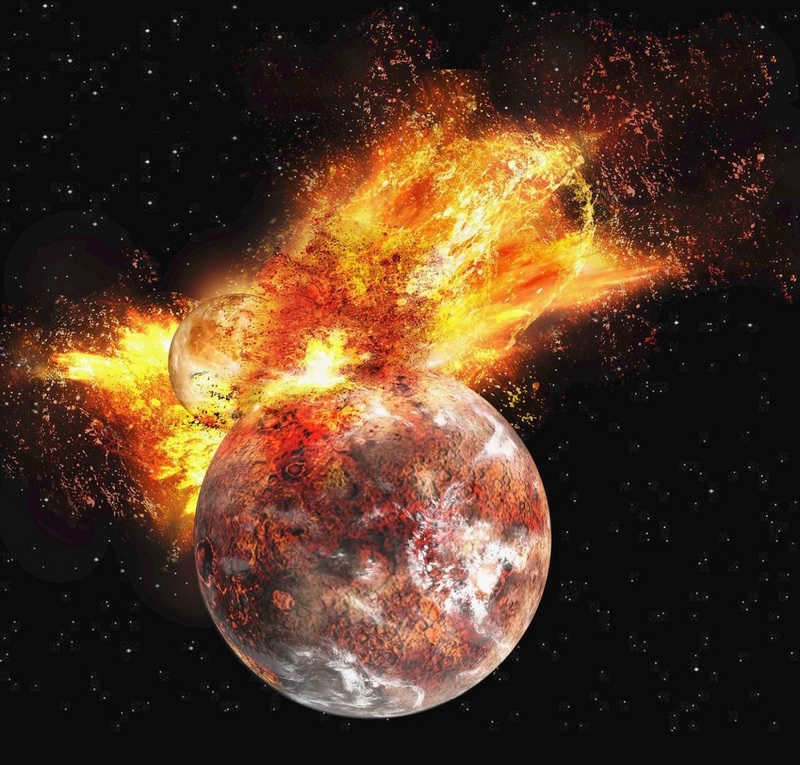
By the time the Moon and Earth collide, they will both transform into blazing fireballs.
As the Moon gets closer to the planet, it will start spinning at an incredible speed due to the Earth’s rotation. Its velocity will surpass 1000 km/h, causing the satellite’s shape to distort. Once it crosses the Roche limit and loses its own gravitational force, the Moon will disintegrate, with its fragments descending towards Earth. The impact on the planet’s surface will happen gradually, but humans won’t survive the cataclysmic event as the destruction of the Moon will result in a massive release of heat and energy.
If the moon were to depart from Earth, catastrophic events would occur. Oceans would eventually evaporate, causing the planet’s surface to heat up. The ridges and mountains would gradually melt, resulting in a fusion of the two objects. Eventually, the Earth would transform into a molten rock, which would then cool down and form a new planet. It is possible that a fraction of humanity could survive this drastic change and find a way to recreate matter. However, it is also possible that all forms of life would disappear.
The Consequences of the Moon’s Departure
In an alternate and extraordinary scenario, the moon could potentially separate from the Earth. This would cause a significant shift in the planet’s axis, which is currently stabilized by the moon’s gravitational pull. If this separation were to occur, the oceans would rush onto the land due to the change in gravitational forces. However, the rotation of the Earth would not come to a halt. While this process would be slow, humanity would have time to adapt and adjust to the absence of tides.
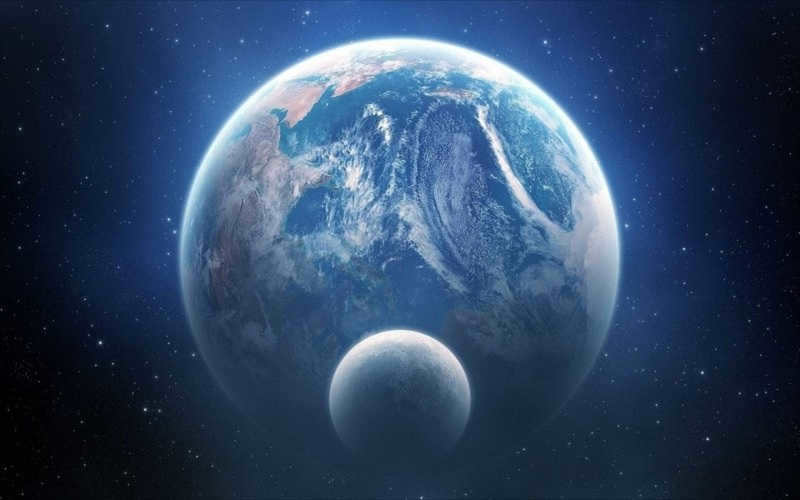

When the Moon moves away, the oceans will scatter across the entire Earth’s surface.
Naturally, the biosphere will be affected by the loss of a gravitational constant, ultimately leading to the demise of all life on Earth.
Both outcomes cannot be viewed positively as everything in outer space is interconnected. Without such a dependable neighbor, life could not have emerged on Earth. It is reassuring to know that these changes will not occur anytime soon. Many future generations, spanning millions of years, will have the opportunity to peacefully live out their lives.
Some intriguing information regarding the Moon
– To visually compare the sizes of the Moon, the Earth, and the Sun, it is necessary to place a regular pea (representing the Moon), a five-ruble coin (representing the Earth), and a double-leaf door (representing the Sun) next to each other.
– A complete lunar day lasts for 29 Earth days, and the Moon completes one orbit around the Earth in 27 of our days.
– The Moon does not possess any natural satellites of its own.
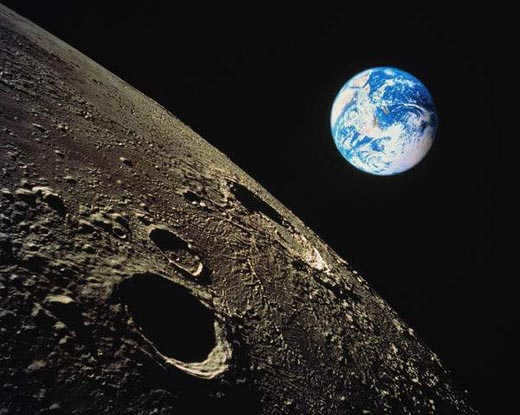
– The Earth and the Moon differ in size, with the Earth being significantly larger. The Moon lacks a protective atmosphere, leaving it vulnerable to meteorite impacts. As a result, the Moon’s surface is marked by countless craters formed from collisions with celestial rocks of varying sizes.
– Another consequence of the Moon’s lack of atmosphere is its extreme cold at night. Water can only exist on the Moon in a frozen state, making it impossible for any living organism to survive. If there ever was life on the Moon, it has long since perished.
Discovering the Moon
The Moon has been extensively researched by humans and remains the most thoroughly studied celestial body. Researchers from various countries have launched over 100 different spacecraft to explore and examine it. Many of these spacecraft have orbited the Moon and transmitted valuable data back to Earth.
In 1959, the Soviet Union achieved a significant milestone by launching the Luna-1 spacecraft. This spacecraft ventured close to the lunar surface and collected the first-ever direct measurements of the Moon’s physical characteristics. It was during this mission that scientists discovered the Moon lacks its own magnetic field, distinguishing it from the Earth.
The Soviet space program successfully deployed a series of automated stations to the Moon, although there were a few unsuccessful attempts. Nevertheless, even these failed lunar modules were able to capture and transmit images of the Moon’s surface, providing valuable insights.
In 1966, a Soviet vehicle became the first to successfully land on the Moon and transmit images back to Earth. This historic event marked a significant achievement in space exploration. The unmanned research complex Luna-16, launched in 1970, also made a soft landing on the Moon’s surface and successfully collected soil samples before returning to Earth.
Furthermore, the USSR successfully delivered two automated Lunokhod modules to the Moon’s surface. The first module operated for a remarkable 10 months, covering over 10 kilometers of the Moon’s surface. The second module operated for approximately 4 months and traveled an impressive 37 kilometers.
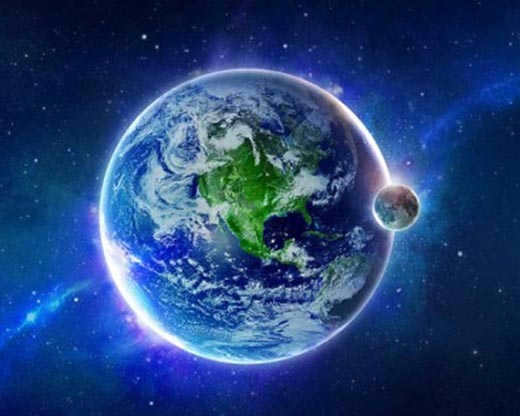
A total of 6 expeditions were launched by the United States to the Moon, with astronauts successfully reaching and returning from the lunar surface. Before the Apollo manned program, American explorers made several unsuccessful attempts to land automatic stations softly, resulting in the vehicles crashing upon collision with the lunar surface.
All manned launches took place between 1969 and 1972, and all were successful. It is widely accepted that the first person to step foot on the lunar surface was American astronaut Neil Armstrong in 1969.
Video
By watching this video, you will gain an understanding of the distance between the Moon and Earth.





